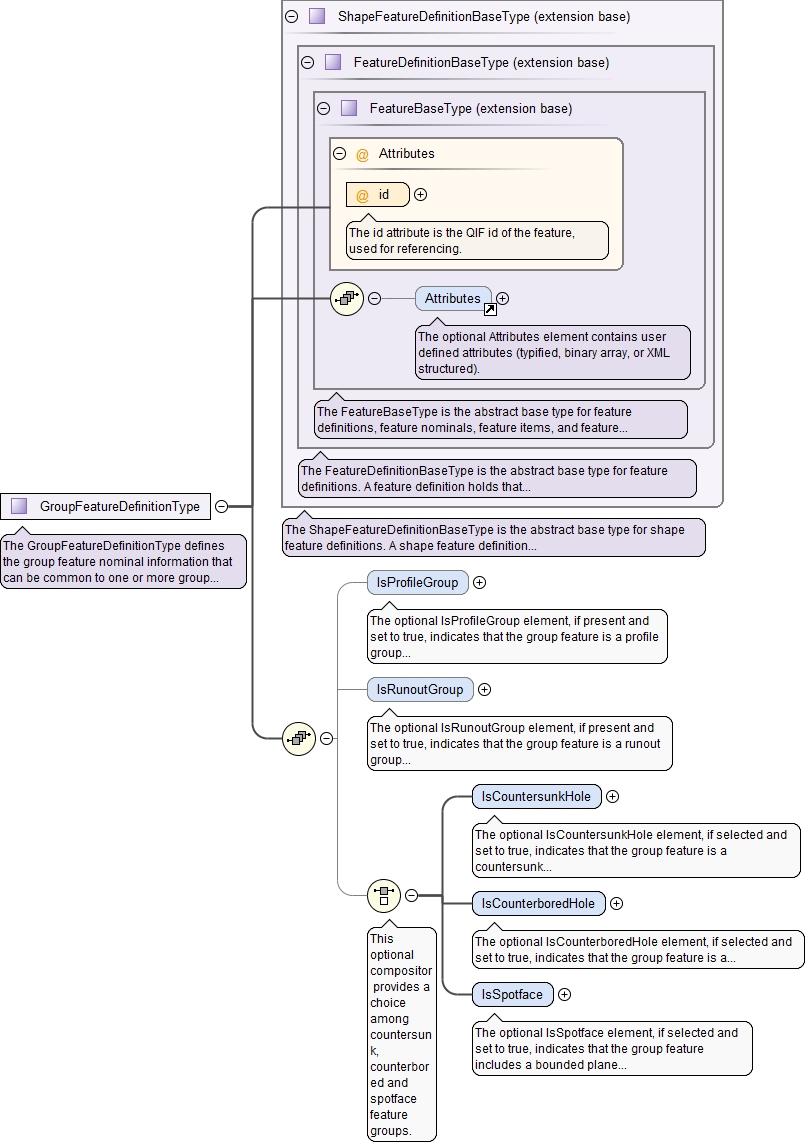<xs:complexType name="GroupFeatureDefinitionType">
<xs:annotation>
<xs:documentation>The GroupFeatureDefinitionType defines the group feature nominal information that can be common to one or more group features.</xs:documentation>
</xs:annotation>
<xs:complexContent>
<xs:extension base="ShapeFeatureDefinitionBaseType">
<xs:sequence>
<xs:element name="IsProfileGroup" type="xs:boolean" minOccurs="0">
<xs:annotation>
<xs:documentation>The optional IsProfileGroup element, if present and set to true, indicates that the group feature is a profile group feature. A profile group feature is a complex feature defined by a set of simple features grouped together (e.g., all sides of an inner pocket), to which a common profile tolerance may be applied.</xs:documentation>
</xs:annotation>
</xs:element>
<xs:element name="IsRunoutGroup" type="xs:boolean" minOccurs="0">
<xs:annotation>
<xs:documentation>The optional IsRunoutGroup element, if present and set to true, indicates that the group feature is a runout group feature. A runout group feature is a complex feature defined by a set of simple features grouped together (e.g., all entities that rotate about or at right angle to a single axis) to which a common runout tolerance may be applied.</xs:documentation>
</xs:annotation>
</xs:element>
<xs:choice minOccurs="0">
<xs:annotation>
<xs:documentation>This optional compositor provides a choice among countersunk, counterbored and spotface feature groups.</xs:documentation>
</xs:annotation>
<xs:element name="IsCountersunkHole" type="xs:boolean">
<xs:annotation>
<xs:documentation>The optional IsCountersunkHole element, if selected and set to true, indicates that the group feature is a countersunk hole consisting of two coaxial internal features. One is a cylinder (or internal thread), the other a cone with an end diameter larger than that of the cylinder. The cone joins one end of the cylinder. The primary intent of having the IsCountersunkHole element is to represent a countersink as defined by standards such as ASME Y14.5 and included in the output of many CAD systems. This element is in an optional choice.</xs:documentation>
</xs:annotation>
</xs:element>
<xs:element name="IsCounterboredHole" type="xs:boolean">
<xs:annotation>
<xs:documentation>The optional IsCounterboredHole element, if selected and set to true, indicates that the group feature is a counterbored hole consisting of two or three coaxial internal features. One is a cylinder that has been counterbored, another is a second, coaxial cylinder (the counterboring) with a diameter larger than that of the first cylinder. If there is a third feature in the group, it is the surface between the two cylinders, which might, for example, be a toroidal segment, a spherical segment, a conical segment, or an annular portion of a plane. The primary intent of having the IsCounterboredHole element is to represent a counterbore as defined by standards such as ASME Y14.5 and included in the output of many CAD systems. This element is in an optional choice.</xs:documentation>
</xs:annotation>
</xs:element>
<xs:element name="IsSpotface" type="xs:boolean">
<xs:annotation>
<xs:documentation>The optional IsSpotface element, if selected and set to true, indicates that the group feature includes a bounded plane feature formed by a spotface operation. The primary intent of having the IsSpotface element is to represent a spotface as defined by standards such as ASME Y14.5 and included in the output of many CAD systems. This element is in an optional choice.</xs:documentation>
</xs:annotation>
</xs:element>
</xs:choice>
</xs:sequence>
</xs:extension>
</xs:complexContent>
</xs:complexType> |





